Current Research Areas
My current research interests are principally in the following areas:
- Mobile Sensing and Computing (IoT-based sensing, backscatter sensing)
- Context Recognition (Congestions in urban areas, human activities)
- Healthcare (Body core temperature estimation)
Battery-less IoT
The number of IoT devices is expected to be enormous, causing huge effort to maintain batteries. In this research, I realize cooperation among battery-less sensors by combining energy harvesting and ambient backscatter which connects sensors wirelessly with tiny energy consumption. The goal is to develop technologies for “Sustainable IoT platform”, which combines energy harvested at multiple devices to satisfy application requirements.
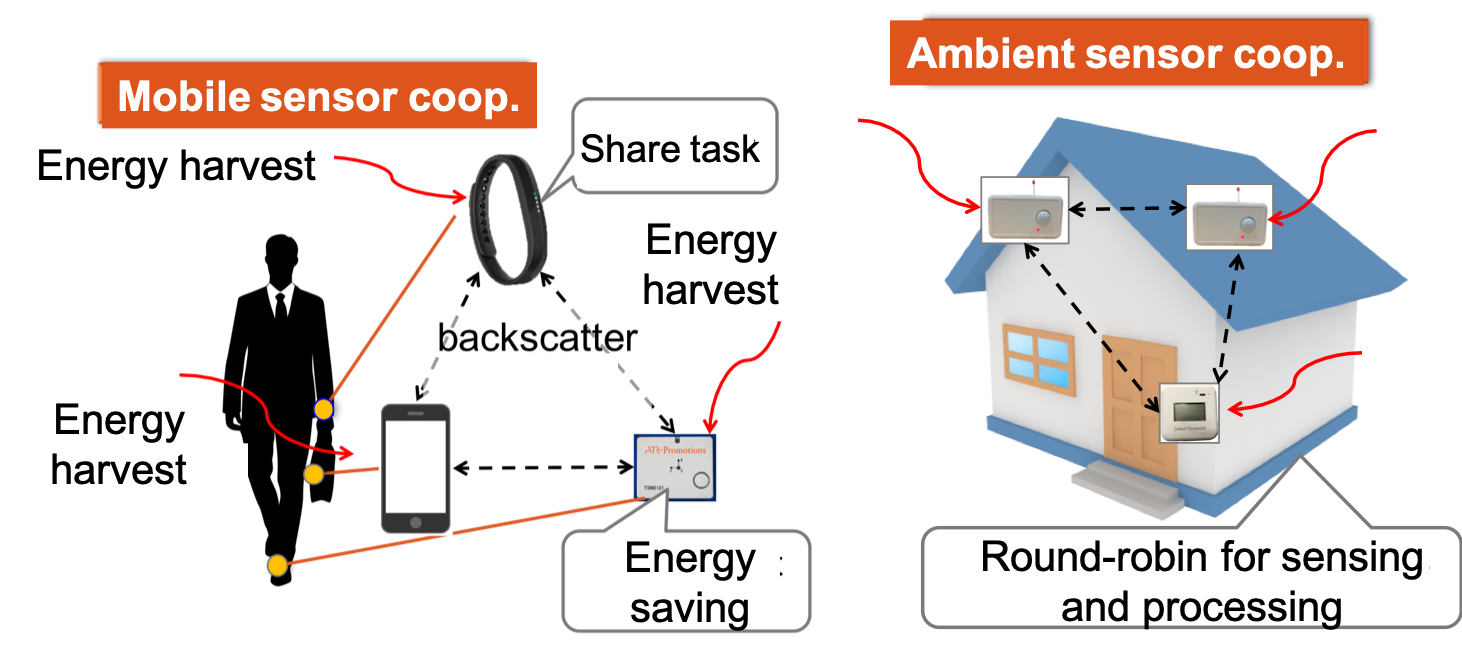
Urban Context Recognition
CrowdMeter: Congestion Estimation in Train Stations
We propose CrowdMeter: a participatory system that leverages the sensed data collected from users' phones during their daily train commutes to gauge the real-time congestion level in railway stations. CrowdMeter tracks the passenger's position in the station as well as identifies her/his context (e.g., waiting for a train, buying a ticket) along with her trajectory from the station's entrance to the train. Therefrom, CrowdMeter extracts novel features, based on the user's location and context, from the phone sensors. These features capture the passenger's behavior (e.g., the walking pattern) and the ambient environment characteristics (e.g., the ambient sound) that can indicate the surrounding congestion level along the passenger's route in a railway station. Finally, the system highlights each area of the station with a specific color (blue, yellow or red) that corresponds to one of three congestion levels (low, medium and high). Evaluation of CrowdMeter through a field experiment in 29 different train stations in Japan shows that it can infer the congestion levels accurately, highlighting its promise as a ubiquitous travel-support service.
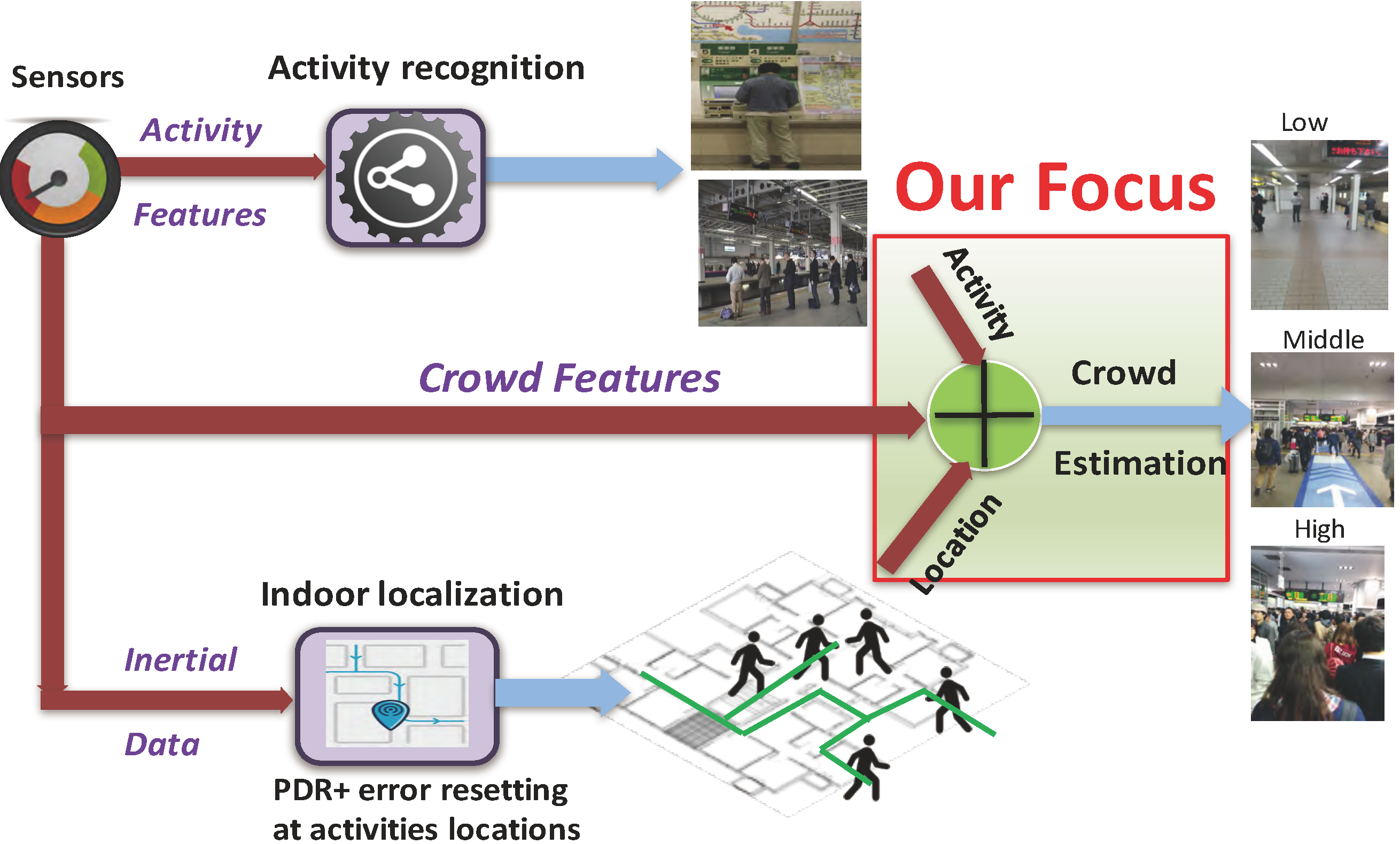
TransitLabel: Semanticin Train Stations
We propose TransitLabel, a crowd-sensing system for automatic enrichment of transit stations indoor floorplans with different semantics like ticket vending machines, entrance gates, drink vending machines, platforms, cars’ waiting lines, restrooms, lockers, waiting (sitting) areas, among others. Our key observations show that certain passengers’ activities (e.g., purchasing tickets, crossing entrance gates, etc) present identifiable signatures on one or more cellphone sensors. TransitLabel leverages this fact to automatically and unobtrusively recognize different passengers’ activities, which in turn are mined to infer their uniquely associated stations semantics. Furthermore, the locations of the discovered semantics are automatically estimated from the inaccurate passengers’ positions when these semantics are identified. We evaluate TransitLabel through a field experiment in eight different train stations in Japan. Our results show that TransitLabel can detect the fine-grained stations semantics accurately with 7.7% false positive rate and 7.5% false negative rate on average. In addition, it can consistently detect the location of discovered semantics accurately, achieving an error within 2.5m on average for all semantics. Finally, we show that TransitLabel has a small energy footprint on cellphones, could be generalized to other stations, and is robust to different phone placements; highlighting its promise as a ubiquitous indoor maps enriching service.
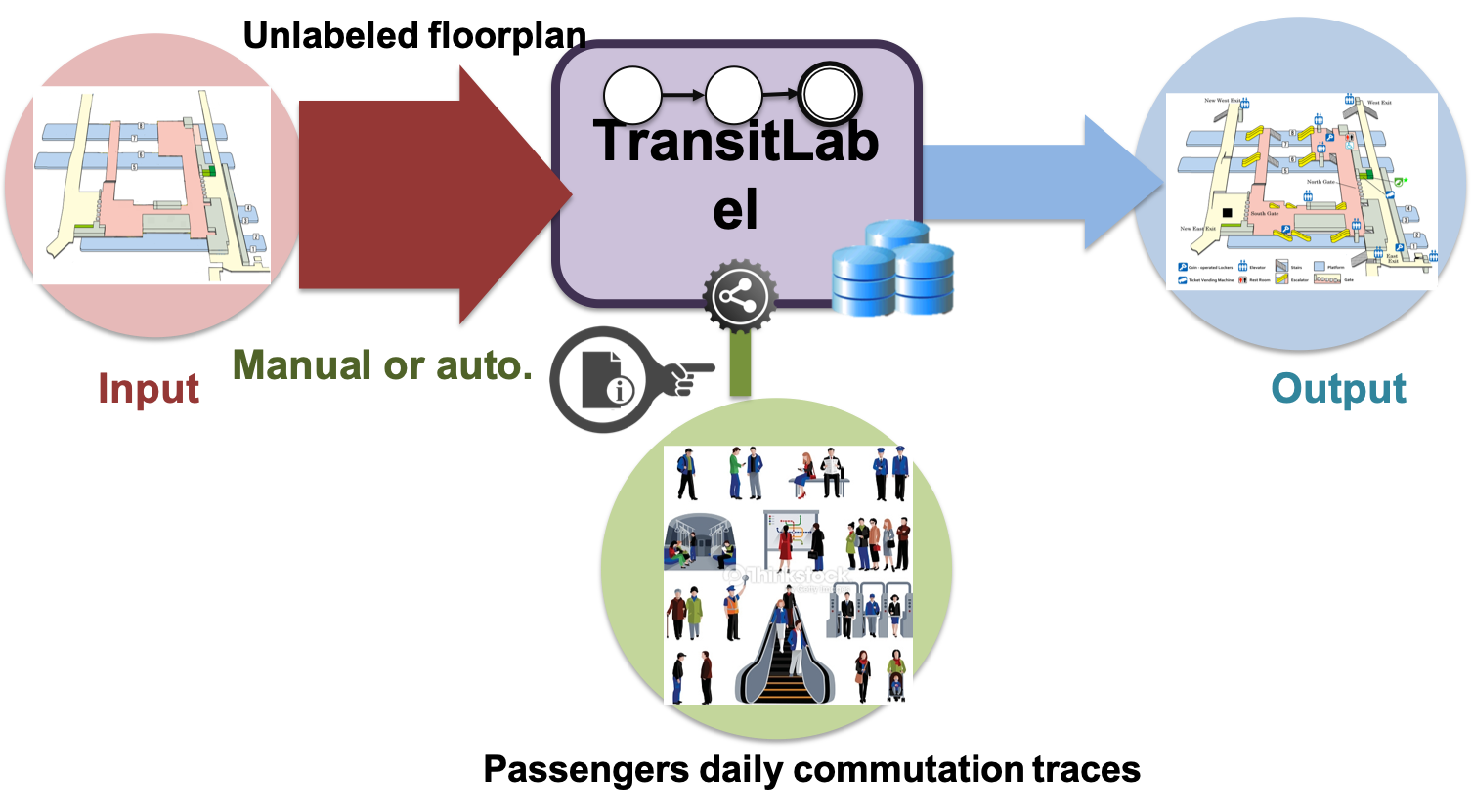
Healthcare
Core Temperature Estimation
We proposed a novel method to estimate core temperature based on a human thermal model considering individual differences. The method employs Gagge’s two-node model to simulate the change of core and skin temperature by calculating heat production in the body and heat exchange between the core node, the skin node, and the environment. In the warm-up, the proposed method determines the optimal parameter set representing individual thermoregulation function and physical feature through exhaustive simulation for comprehensive combinations of parameters. We also proposed various modifications for the original model in order to improve the estimation accuracy such as delaying thermal transfer and thermoregulation response. We have evaluated the proposed method through more than 120 hours of real experiments in running, walking, biking and tennis. The results show that the proposed method can successfully determine parameter sets which reduce estimation errors. The novel idea to estimate core body temperature by fusion of multimodal sensor data was very successful, leading to the collaboration with several companies and researchers in other fields.
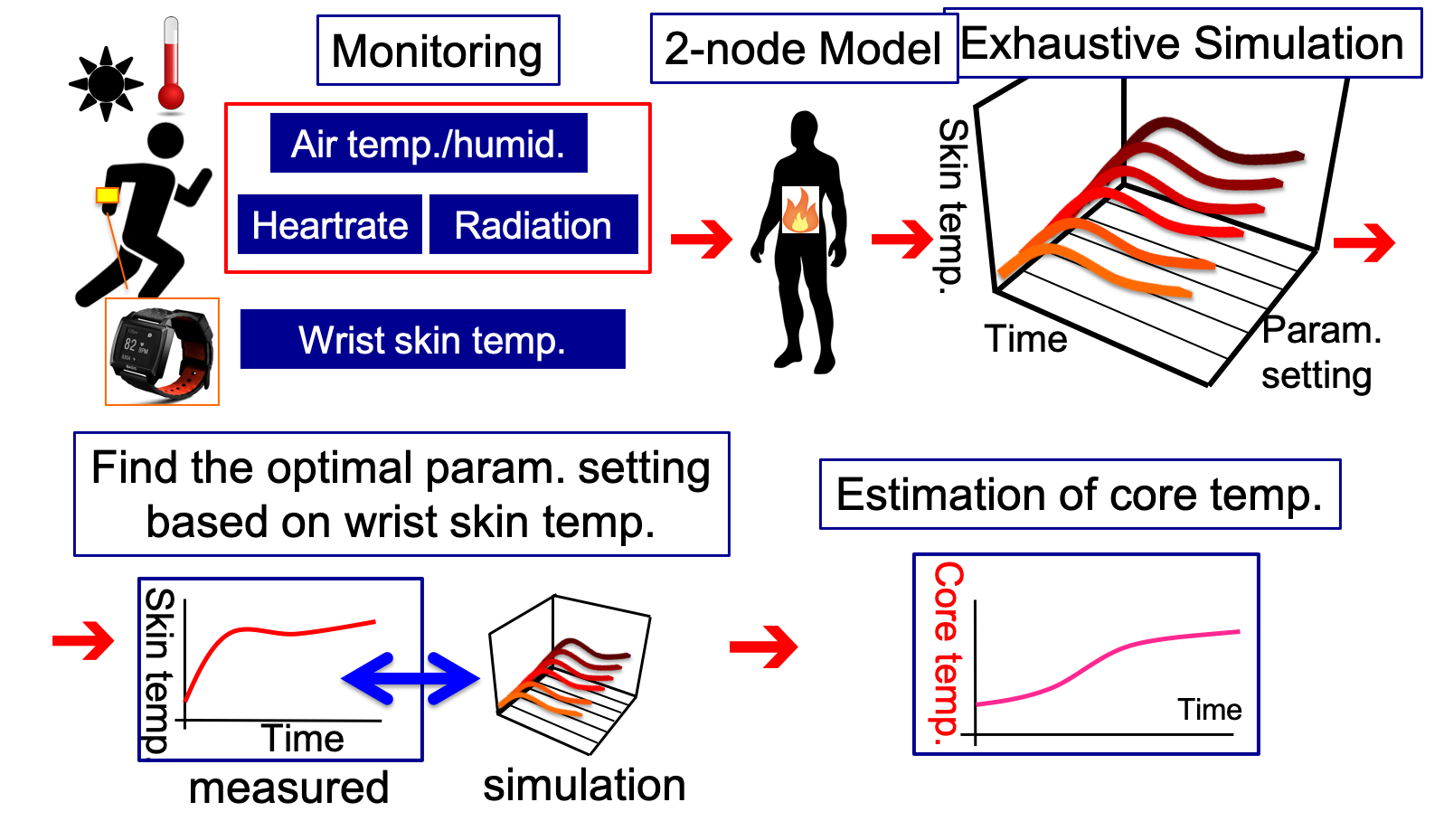
FluidMeter: Fluid Intake Amount Estimation
Water is the most vital nutrient in the human body accounting for about 60% of the body weight. To maintain optimal health, it is important for humans to consume a sufficient amount of fluids daily. Therefore, tracking the amount of human daily fluid intake has a myriad of health applications like dehydration prevention. In this research, we present FluidMeter: a ubiquitous and unobtrusive system to track the amount of fluid intake leveraging the inertial sensors embedded in smartwatches. To achieve this, FluidMeter first separates the drinking activities from other human activities (playing, running, eating, etc.). Thereafter, it analyzes the sampled sensors data during the extracted drinking episodes to recognize the sequence of micro-activities (lift the bottle, sip, release the bottle) that constitute the drinking activity. Finally, it applies some machine learning algorithms on some features extracted from sampled sensor data during the sipping period to gauge the amount of fluid intake in the designated drinking episode. FluidMeter is evaluated by collecting more than 260 hours of different human activities by 70 different participants using different smartwatch models. The results show that FluidMeter can recognize the drinking activity and its micro-activities accurately which is comparable to that achieved by the state-of-the-art techniques. Finally, FluidMeter can estimate the overall amount of fluid intake in grams accurately with a estimation error limited to 15%, highlighting its promise as a ubiquitous health service.

Mobile Localization
We proposed a novel idea leveraging ad hoc communication among mobile devices to improve localization performance. In this work, we proposed an opportunistic ad-hoc localization algorithm called Urban Pedestrians Localization (UPL), for estimating locations of mobile nodes in urban districts. The design principles of UPL are twofold. First, UPL assumes that location landmarks are deployed sparsely due to deployment-cost constraints. Thus, most mobile nodes cannot expect to meet these location landmarks frequently. Each mobile node in UPL relies on location information received from its neighboring mobile nodes instead in order to estimate its area of presence in which the node is expected to exist. Although the area of presence of each mobile node becomes inexact as it moves, it can be used to reduce the areas of presence of the others. Second, UPL employs information about obstacles such as walls and presents an algorithm to calculate the movable areas of mobile nodes considering obstacles for predicting the area of presence of mobile nodes accurately under mobility. This also helps to reduce each node’s area of presence. The experimental results have shown that UPL could limit the positioning error to 0.7r on average by the above two key ideas, where r denotes the radio range.
Also, we worked for mobile phone localization for firefighters. The localization method utilizes WiFi directional antennas placed around a target building. We also published several works related to localization in international conferences and journal papers for novel metrics considering relative positions, people density estimation, and GPS improvement.
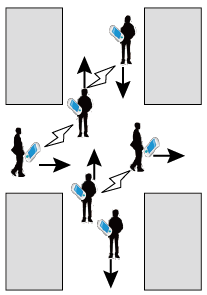
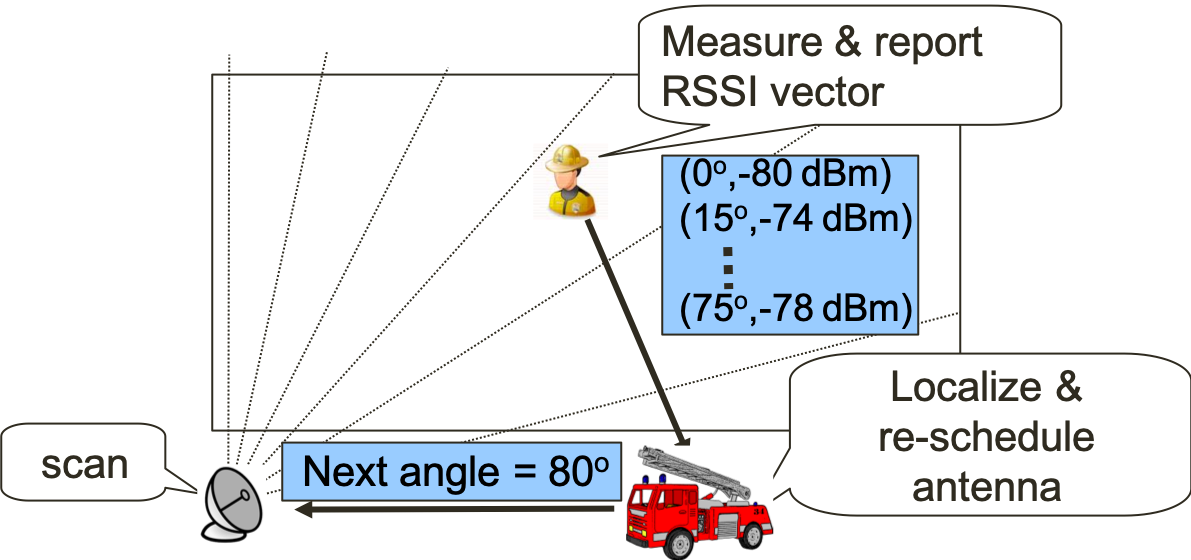
Funded Research Projects
- "Development of Sustainable IoT Platform by Wireless Sensing", Principal Investigator, Japan Science and Technology Agency PRESTO, 2019-2022.
- "Development of battery less sensing systems using ambient backscatter communication", Co-Investigator, JSPS Grant-in-Aid for Scientific Research (KAKENHI) Challenging Research (Pioneering), 2018-present.
- "Sports Research Innovation Project (SRIP)", Japan Sports Agency, Ministry of Education, Culture, Sports, Science and Technology (MEXT), 2015-present.
- "Context Sensing by Participatory Sensing in Urban Transportation", Pricipal Investigator, JSPS Grant-in-Aid for Young Scientists (A), 2014-2017.
- "Development of Sustainable IoT Platform by Cooperative Battery-less Sensors", Principal Investigator, Japan Science and Technology Agency ACT-I, 2016-2017.
- "Real Time and Low Cost Core Temperature Estimation Using Wearable Sensors", Principal Investigator, JSPS Grant-in-Aid for Challenging Exploratory Research, 2014-2015.
- "Robust and Low Cost WLAN Localization for Device Heterogeneity", Principal Investigator, JSPS Grant-in-Aid for Young Scientists (B), 2011-2013.
- "Highly Efficient Density Estimation for Mobile Nodes using Ad Hoc Communication in Ubiquitous Networks", Principal Investigator, JSPS Grant-in-Aid for Research Activity Start-up, 2009-2010.